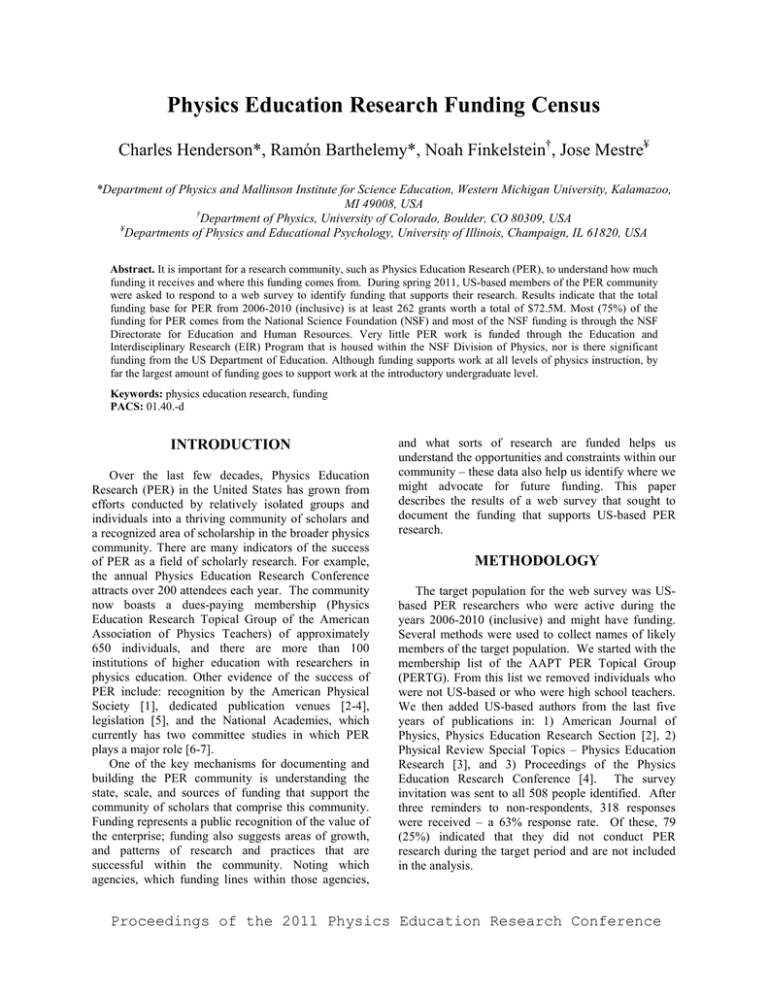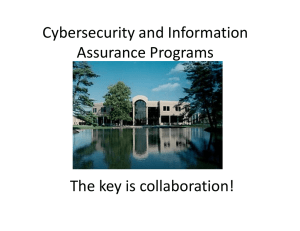Physics Education Research Funding Census Charles Henderson*, Ramón Barthelemy*, Noah Finkelstein
advertisement

Physics Education Research Funding Census Charles Henderson*, Ramón Barthelemy*, Noah Finkelstein†, Jose Mestre¥ *Department of Physics and Mallinson Institute for Science Education, Western Michigan University, Kalamazoo, MI 49008, USA † Department of Physics, University of Colorado, Boulder, CO 80309, USA ¥ Departments of Physics and Educational Psychology, University of Illinois, Champaign, IL 61820, USA Abstract. It is important for a research community, such as Physics Education Research (PER), to understand how much funding it receives and where this funding comes from. During spring 2011, US-based members of the PER community were asked to respond to a web survey to identify funding that supports their research. Results indicate that the total funding base for PER from 2006-2010 (inclusive) is at least 262 grants worth a total of $72.5M. Most (75%) of the funding for PER comes from the National Science Foundation (NSF) and most of the NSF funding is through the NSF Directorate for Education and Human Resources. Very little PER work is funded through the Education and Interdisciplinary Research (EIR) Program that is housed within the NSF Division of Physics, nor is there significant funding from the US Department of Education. Although funding supports work at all levels of physics instruction, by far the largest amount of funding goes to support work at the introductory undergraduate level. Keywords: physics education research, funding PACS: 01.40.-d INTRODUCTION Over the last few decades, Physics Education Research (PER) in the United States has grown from efforts conducted by relatively isolated groups and individuals into a thriving community of scholars and a recognized area of scholarship in the broader physics community. There are many indicators of the success of PER as a field of scholarly research. For example, the annual Physics Education Research Conference attracts over 200 attendees each year. The community now boasts a dues-paying membership (Physics Education Research Topical Group of the American Association of Physics Teachers) of approximately 650 individuals, and there are more than 100 institutions of higher education with researchers in physics education. Other evidence of the success of PER include: recognition by the American Physical Society [1], dedicated publication venues [2-4], legislation [5], and the National Academies, which currently has two committee studies in which PER plays a major role [6-7]. One of the key mechanisms for documenting and building the PER community is understanding the state, scale, and sources of funding that support the community of scholars that comprise this community. Funding represents a public recognition of the value of the enterprise; funding also suggests areas of growth, and patterns of research and practices that are successful within the community. Noting which agencies, which funding lines within those agencies, and what sorts of research are funded helps us understand the opportunities and constraints within our community – these data also help us identify where we might advocate for future funding. This paper describes the results of a web survey that sought to document the funding that supports US-based PER research. METHODOLOGY The target population for the web survey was USbased PER researchers who were active during the years 2006-2010 (inclusive) and might have funding. Several methods were used to collect names of likely members of the target population. We started with the membership list of the AAPT PER Topical Group (PERTG). From this list we removed individuals who were not US-based or who were high school teachers. We then added US-based authors from the last five years of publications in: 1) American Journal of Physics, Physics Education Research Section [2], 2) Physical Review Special Topics – Physics Education Research [3], and 3) Proceedings of the Physics Education Research Conference [4]. The survey invitation was sent to all 508 people identified. After three reminders to non-respondents, 318 responses were received – a 63% response rate. Of these, 79 (25%) indicated that they did not conduct PER research during the target period and are not included in the analysis. Proceedings of the 2011 Physics Education Research Conference In addition to the grants identified from the web survey, separate searches were conducted of the NSF grants database. Specific non-respondents who were identified by the authors as likely to have grants were searched for by name. Key word searches were conducted using ‘physics’ and ‘education’. Resulting ‘hits’ from both types of searches were then judged as to whether they represented PER. Grant totals were adjusted to account for grants that extended outside of the 2006-2010 target range and grants that included both PER and non-PER activities. Duplicated grants were removed from the database. RESULTS FIGURE 1. Number of grants reported by each PER researcher. Demographics of PER Researchers The demographics of survey respondents provide information about the characteristics of PER researchers. The results presented in this section are based on responses of the 237 respondents who selfreported to have conducted PER in the US between 2006 and 2010. Figure 1 shows that approximately 55% of selfidentified PER researchers have one or more grants. Figure 2 shows that 43% of the respondents have a PhD in a traditional area of physics, while another 33% have a PhD in PER. Figure 3 shows that 41% of respondents work at an institution offering a Physics PhD. Most (70%) of respondents have their appointment in a Physics Department with many fewer holding appointments in education-related departments (10%) or joint appointments (8%). FIGURE 2. Type of PhD held by respondents. Funding Sources and Amounts The web survey identified 186 grants worth a total of $46.1M (Table 1). Of these, 112 grants worth a total of $34.5M were from the National Science Foundation (NSF). The searches of the NSF database identified an additional 46 grants worth a total of $19.3M. Assuming that the web survey failed to capture the same proportion of funding from non-NSF sources as from NSF sources, there would be an additional 30 non-NSF grants worth a total of $7.2M. Thus, the total funding base for PER from 20062010 (inclusive) can be estimated to be at least 262 grants worth a total of $72.5M. We have almost certainly failed to capture all of the PER funding, but estimate that the total funding level is likely to be within a factor of 2 of these values. Table 1 summarizes the funding sources and amounts. Approximately 75% of funding for PER comes from the NSF. Table 2 shows a breakdown of NSF funding by program. Note that a few grants were FIGURE 3. Type of Institution. Highest physics degree offered by respondent’s institution. jointly funded by more than one program and are counted for each. Of the NSF programs, CCLI/TUES has been the most productive support for PER, resulting in 34% of all NSF funding. Grant Activities Figures 4 and 5 show the types of activities that grants supported. The results are based only on the responses to the web survey and respondents could select more than one category for each grant. Figure 4 TABLE 1. Summary of all funding for PER (from survey responses and NSF database search). Funding Number Ave grant Source ($K) of Grants size ($K) NSF Total 55,923 158 367 Survey 34,534 112 346 Added 19,282 46 419 State* 3,974 9 442 US Dept. of 2,129 7 304 Education Foundation** 1,749 13 135 Institution*** 400 24 17 Other 3,309 21 158 *All state-level funding. Most commonly through the state Department of Education **All foundation funding (e.g., Hewlett, HHMI, Microsoft) ***All institutional-level funding TABLE 2. Summary of NSF funding for PER (from survey responses and NSF database search). Funding Number Ave grant Source ($K) of Grants size ($K) CCLI/TUES 18,971 64 296 Type1 5,586 33 169 Type2 8,354 24 348 Type3 5,031 7 719 S-Stem 13,013 50 260 DR K-12 9,143 10 914 REESE/ROLE 5,499 9 611 National STEM 3,437 5 687 DIGITAL LIBRARY Robert Noyce 3,344 8 418 Physics Educ 2,247 5 449 (EIR) in PHY Other 10,753 16 672 FIGURE 4. Level of physics instruction targeted by grant project. FIGURE 5. Types of activities supported by funding. Figure 6 shows that full professors have the highest funding levels. Figure 7 shows that PhDs in traditional areas of physics receive more funding than PhDs in PER. This most likely reflects the historical artifact in PER that full professors are most likely to have received a PhD in a traditional area of physics and then switched to PER. While assistant or associate professors are more likely to have a PhD in PER. Figure 8 shows that the type of academic appointment is not related to the amount of funding received. CONCLUSIONS shows that by far the largest amount of funding goes to support work at the introductory undergraduate level. Figure 5 shows that curriculum development receives the largest amount of funding, followed by basic research and dissemination/professional development. Characteristics of Grant Recipients Figures 6-8 show how selected demographic characteristics are related to the amount of external funding received (reported in number of grant dollars per person per year). The average funding amounts shown here are based only on the responses to the web survey of those who reported external funding. Figures 6-8 also show the percentage of researchers in each category who reported having external funding. These results of this PER funding census provide an important perspective on the PER community. Perhaps the most important finding is that the scale of funding that supports PER is significant. We conclude that the total funding base for PER from 2006-2010 (inclusive) is at least 262 grants worth a total of $72.5M. We also find that this funding supports a range of research activities, from basic research to curriculum development and dissemination. Most (75%) of the funding for PER comes from the NSF and most of the NSF funding is through three programs that are run by the NSF Directorate for Education and Human Resources: CCLI/TUES, SSTEM, DR-K12. These are all programs with primary goals of supporting educational practice rather than FIGURE 6. Academic rank of researcher compared to funding received. FIGURE 7. PhD field of researcher compared to funding received. dedicated to providing funding for PER. This is coupled with the growing Discipline-Based Educational Research (DBER) movement, of which PER is a part, that similarly has no dedicated funding source. Further, although not a direct finding of this project, we note that PER funding, as is the case for all other STEM education funding, is almost always awarded on a project-by-project basis. This is in contrast to the funding of some areas of traditional physics and STEM fields, which have mechanisms (e.g., renewals) to support productive research programs over an extended period of time. Thus, it is important for the PER and DBER communities to consider their funding needs and make the case to funding agencies (most specifically the NSF) about why and how these needs should be supported. We also note that it is important for PER to look beyond the NSF for funding. There are many foundations that have supported PER. Although some funding has been received from the relatively new US Department of Education’s Institute of Education Sciences, a lack of awareness of this program within PER, perhaps coupled with a lack of awareness by the Department of Education of PER, may limit the number of successful PER applications. ACKNOWLEDGMENTS We wish to thank the Physics Education Research Leadership and Organizing Council and the American Association of Physics Teachers for their support of this project. REFERENCES FIGURE 8. Type of appointment compared to funding received. basic research. Thus, the basic research capacity of PER may be constrained by a lack of appropriate funding opportunities. For example, much smaller amounts of funding come from the more researchfocused REESE program. And, very little PER work is funded through the Education and Interdisciplinary Research (EIR) Program that is housed within the Division of Physics (PHY). If the field of PER is to grow, it is important for the PER community to find additional funding sources. We note that, unlike many traditional areas of physics, there is no program at the NSF or elsewhere that is 1. American Physical Society (1999), Statement 99:2, Research in Physics Education, http://www.aps.org/policy/statements/99_2.cfm 2. AAPT, Physics Education Research Section of the American Journal of Physics, http://www.kzoo.edu/ajp/docs/pers.html 3. APS, Physical Review Special Topics: Physics Education Research, http://prst-per.aps.org 4. AIP, Proceedings of the Physics Education Research Conference 5 For example, see explicit reference to DBER in HR5116: American COMPETES reauthorization (2011), and in the Office of Science Technology and Policy priorities in STEM Education, “Winning the Race to Educate Our Children,” 14 Feb 2011. 6 Status, Contributions, and Future Directions of Discipline Based Education Research, http://www7.nationalacademies.org/bose/DBER_Homep age.html 7 Undergraduate Physics Education Research and Implementation, http://sites.nationalacademies.org/BPA/BPA_059078







